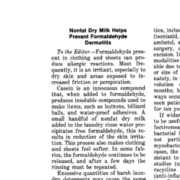A day in the life of a patch tester – Glove Protection – Formaldehyde
It’s so true not all gloves are created equally! There’s thickness, pliability, and then there is materials!!! Did you know that latex does NOT adequately protect against formaldehyde? It is INADEQUATE.
Oh yes! Have seen fresh young medical student sensitized in anatomy lab by using [and reusing 🙁 ] latex gloves… when instead they should have been doubling up on the nitrile!
Here’s a great link from Umass, Boston:
https://www.umb.edu/ehs/lab_safety/ch_em_plan/appd
Latex gloves are inadequate, fragile and ‘perform very poorly against Organic Solvents.
They are also INADEQUATE protection for:
Most Aldehydes, including Formaldehyde…
Nitrile, the blue-purple ones, on the other hand, WILL withstand:
Alcohols
Inorganic Acids and Bases including Chromic Acid, and Most Organic Acids
Organosilanes
Organic Nitrates and Nitrites
Some Aldehydes, including Formaldehyde and Glutaraldehyde’


